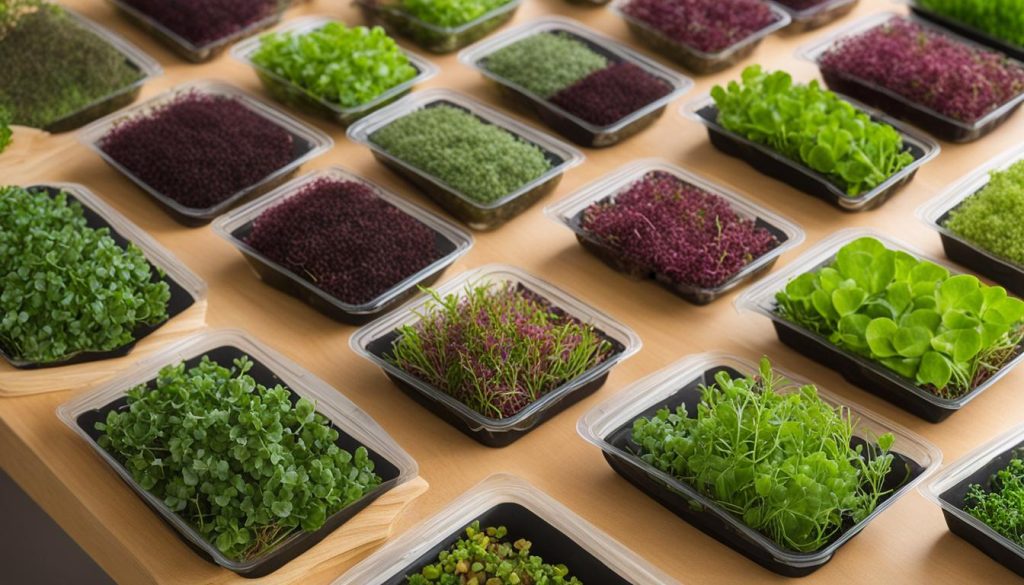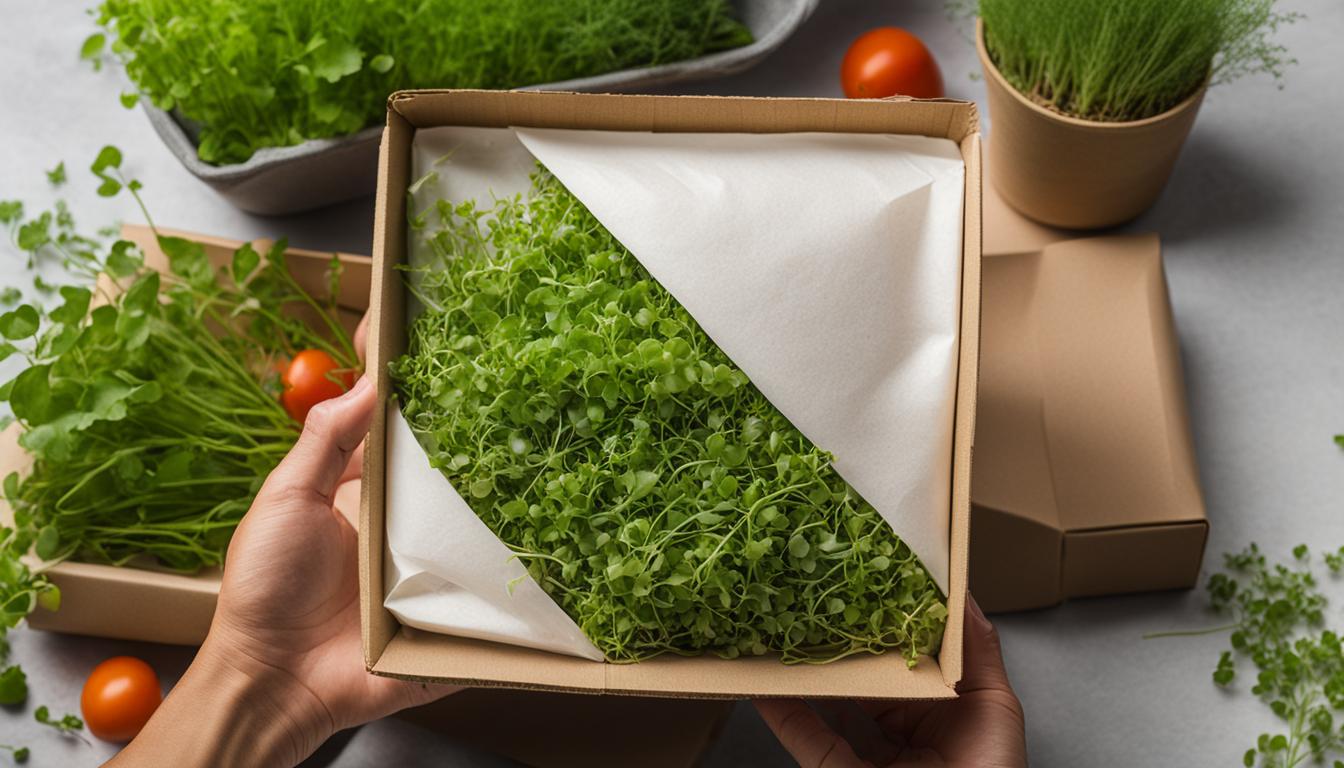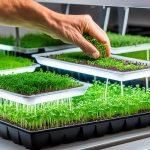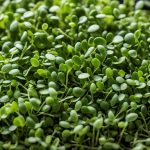As we delve deep into the verdant world of microgreens, the significance of microgreens packaging comes into sharp focus. It’s a component of the consumer experience that does more than just contain; it communicates. The rise of eco-conscious eating has turned the spotlight onto eco-friendly microgreens packaging, propelling sustainable solutions to the forefront of the industry.
Today’s consumers are looking for attributes that resonate with their values, and packaging solutions that are both biodegradable and recyclable meet that call. Moreover, advancements in innovative packaging have resulted in a brilliant merger of functionality and earth-friendliness, presenting brands with a powerful tool to not only protect their delicate product but also their planet.
Understanding the Role of Packaging in Microgreens Consumption
The journey from farm to fridge is not just a physical one for microgreens; it’s also a narrative that unfolds within the customer’s mind, beginning with the very first glance at the packaging. In a market where the attractive packaging for microgreens isn’t just desirable but essential, grasping the full spectrum of packaging’s influence on the customer experience requires an exploration of visual aesthetics, functionality, and environmental impact.
First Impressions: Visual Appeal and Eco-Consciousness
As microgreens make their vibrant debut on store shelves, consumers are greeted with a silent yet powerful presentation. Transparent clamshells, windowed baker’s bags, or poly bags offer a clear view of the freshness and quality of the greens, supported by labels that narrate the product’s story. While this visual appeal captivates and informs, it is the commitment to eco-consciousness that sustains the narrative. The growing demand for biodegradable packaging for microgreens reflects a consumer base that is as concerned with environmental ethics as it is with aesthetic appeal.
User Convenience: Size, Shape, and Ease of Use
Beyond the initial allure lies the pragmatic aspects of packaging. How well does it fit in the fridge? Is it resealable? Can it be stored without hassle? The attractive packaging that wins hearts is also the packaging that accommodates the contours of convenience—compact, user-friendly, and considerate of the spatial constraints typical of both home and commercial settings. This convenience is a cornerstone of exceptional customer experience, ensuring that form and functionality are in perfect harmony.
Disposal and Recycling: Post-Consumption Impact
As the final chapter of the product life cycle concludes, thoughtful disposal becomes the epilogue to the microgreens’ story. Packaging designed with recycling options for microgreens packaging or compostability in mind offers consumers a guilt-free closure to their purchase. The ability to recycle or return the packaging to nature cements brand loyalty and completes the narrative of a conscious purchase, leaving the customer with a sense of satisfaction that resonates beyond taste.
Microgreens Packaging: Design and Material Considerations
In the world of premium microgreens packaging, excellence is achieved when design considerations complement material quality. The intricacy of creating sustainable packaging for microgreens requires a harmonious fusion of aesthetic appeal with the enduring promise of sustainability. As such, designers and manufacturers must be meticulous in choosing materials that not only safeguard the delicate nature of microgreens but also resonate with the brand’s commitment to environmental stewardship.
The tactile sensation of high-quality materials and the visual delight of a thoughtfully crafted package can substantially elevate a brand’s standing in the eyes of a discerning consumer. Microgreen enthusiasts seek out brands that articulate an unwavering dedication both to their product and to the planet. Consequently, the utilization of materials such as post-consumer recycled plastics, or plant-based bioplastics, speaks volumes to a company’s ethos, potentially converting first-time buyers into loyal advocates.
Moreover, the journey toward sustainable packaging for microgreens is not one of sacrifice but of innovation. By obsessing over design considerations, businesses have the opportunity to spark joy in the unboxing experience, while simultaneously ensuring that the microgreens arrive in pristine condition. It is a testament to how the industry is evolving – where the pursuit of aesthetic attractiveness aligns with a profound respect for the ecosystem.
Exploring Eco-Friendly Materials for Sustainable Packaging
As the demand for greener alternatives soars, the market for microgreens packaging is seeing a significant shift towards materials that echo the sustainability ethos of consumers and businesses alike. Innovations in packaging technology have brought forth a range of options that offer both eco-friendly solutions and practical functionality. From the introduction of biodegradable products to the development of packaging that can easily re-enter the production cycle, the focus is on reducing environmental impact while preserving the delicate nature of microgreens.
Biodegradable Options for Microgreens Packaging
Biodegradable packaging for microgreens is becoming a sought-after choice for businesses looking to minimize their ecological footprint. Created from plant-based materials such as cornstarch, sugarcane, or bamboo, these types of packaging break down organically, seamlessly blending back into earth without leaving harmful residues. Their ability to decompose under natural conditions appeals to the growing market of environmentally conscious consumers and adds a layer of responsibility to the brand’s image.
Recyclable Packaging Solutions for Microgreens
Catering to the cyclical economy model, recyclable microgreens packaging is an effective way to reduce waste. By using materials that can be reprocessed and turned into new products, this approach sustains a closed-loop system, diminishing the demand for virgin resources. Packaging solutions such as PET plastic and cardboard are among the frontrunners in recyclability, offering the resilience required to protect microgreens while ensuring that the packaging doesn’t end up in landfills.
Compostable Alternatives and Their Viability
Compostable packaging for microgreens takes the concept of environmentally friendly packaging a step further by providing materials that not only break down but also support soil health. These innovative solutions often incorporate natural fibers, which upon disposal, turn into beneficial compost, contributing to a nutrient-rich environment. The growth of urban composting initiatives bolsters the viability of compostable packaging and underscores its relevance in a sustainable supply chain.
Innovative Microgreens Packaging Ideas That Stand Out
In the realm of microgreens, traditional packaging solutions are swiftly being overtaken by innovative microgreens packaging designed to catch the consumer’s eye and address environmental concerns. Brands on the forefront are leveraging attractive packaging solutions that not only elevate the aesthetics but also incorporate sustainable practices, creating a stand-out design that resonates with eco-conscious customers.

The market has noted a significant uptrend in unique packaging features, such as containers that offer superior breathability through earth-themed vents. These novel designs help manage the moisture content and thus, extend the shelf-life of microgreens. Moreover, packaging materials that can seamlessly go from sustainably sourced to customer’s table without environmental detriment are in high demand.
Durability and functionality are not forgotten amidst the sea of innovations. Today’s eco-friendly packaging options include those designed for enhanced stacking capabilities, proving invaluable for retailers organizing their displays. Furthermore, the incorporation of hand or machine formability caters to automation in packaging processes, presenting a time-saving advantage for producers.
Challenges such as the recyclability of clamshell designs, previously hindered by label adhesives and other non-recyclable components, are now being ingeniously circumvented. The evolution of this packaging type now sees the adhesives replaced with eco-friendly alternatives, and the entire package redesigned to be more easily processed by recycling facilities. These improvements demonstrate a commitment to sustainable innovation that not only captivates the market but also satisfies the growing consumer demand for responsible packaging practices.
Custom Microgreens Packaging: Tailoring to Brand and Product
When it comes to standing out in the lush field of microgreens, bespoke packaging solutions offer a powerful tool for businesses to mirror their unique brand essence and create a touchpoint that resonates with customers. Not only does this tailored approach serve to establish brand recognition, but it also nurtures an intimate audience connection. It embodies a narrative that customers can identify with each time they encounter your product on the shelves.
Importance of Brand Consistency in Packaging Design
With brand consistency as the cornerstone of trust, custom microgreens packaging becomes more than just a protective exterior; it’s a statement of reliability and quality. Integrating recurring motifs, colors, and logos that align with your marketing strategy ensures that your clients’ experience stays cohesive, reinforcing your brand’s voice and visual identity in every facet.
Personalization: Connecting with Your Audience
The art of audience connection lies in the details—those bespoke touches that speak directly to the consumer’s ethos. Personalization can come in many forms, whether it’s through storytelling elements on the packaging, interactive features, or tailored information that guides and educates. It’s an opportunity to create a memorable brand experience and an emotional bond that leads to loyalty and advocacy.
Evaluating Cost-Effective Custom Packaging Options
Navigating the avenue of cost-effective packaging options requires balancing aesthetic appeal with functional pragmatism. By selecting durable, yet affordable materials that align with eco-friendly aspirations, a brand can construct a packaging experience that appeals to the eco-conscious shopper while maintaining a keen eye on the bottom line. Through this careful curation, businesses can deliver custom microgreens packaging that is both reflective of their brand identity and responsible in its consumption of resources.
Maximizing Shelf Life: Packaging’s Role in Preserving Freshness
The integrity of microgreens, with their delicate structures and nutritional value, hinges greatly on the effectiveness of preserving freshness in all stages of the supply chain. This necessity is magnified when considering the maximizing shelf life of these perishable greens. The optimal packaging solution is not just about containment—it’s a commitment to quality preservation and waste reduction. Implementing sustainable microgreens packaging options serves a dual role: it conveys a message of environmental responsibility while safeguarding the product from field to fork.
Ensuring that microgreens arrive in perfect condition to consumers begins with mastering the science of preservation within the packaging environment. Regulating temperature, humidity, and accessibility to fresh air are key components in extending longevity. Packaging materials that incorporate breathable elements, such as micro-perforations, promote the necessary air circulation without compromising moisture levels. Meanwhile, advanced compostable films and coatings that show resistance to condensation and humidity help in maximizing shelf life.
Transitioning towards packaging that absorbs excess moisture or reflects light to keep microgreens cool is imperative in preventing premature degradation. Such innovations push the boundaries of traditional packaging methods and drive the industry towards a sustainable future.
Types of Microgreens Packaging: From Clamshells to Pouches
As the demand for fresh and sustainable food options surges, the types of microgreens packaging that businesses choose plays an indispensable role in market differentiation and environmental impact. With a myriad of packaging styles now available, the strategy not only revolves around aesthetics and protection but is also deeply rooted in ecological responsibility and material innovation.
Evaluating the Pros and Cons of Different Packaging Styles
In the dynamic world of microgreens packaging, each container comes with its own set of benefits and limitations. Traditional plastic clamshells are often lauded for their transparency and the sturdy barrier they provide. However, their environmental detriment due to challenges in recycling has sparked a significant shift in the industry.
The Shift Towards Eco-Friendly Clamshells in the Market
The revolution in packaging has led to the advent of eco-friendly clamshells. These innovative shells, typically made from high wet strength cardboards or bioplastics, are a response to the call for sustainability while maintaining the functional integrity required for the delicate microgreens. Their introduction marks a significant stride towards reducing plastic use in the packaging domain.
Pouches and Bags: Flexible and Sustainable Choices
On the other side of the spectrum, sustainable pouches and bags present themselves as versatile and environmentally-conscious solutions. They offer the benefit of flexibility in terms of size, shape, and function. Resealable options enhance product longevity, and materials like biodegradable films or vacuum-sealing techniques underscore the commitment to sustainability. For brands and consumers alike, these types of packaging not only preserve and protect but also pave the way for a greener future in food consumption.
Challenges and Solutions in Microgreens Packaging Operations
As the microgreens industry grows, packaging remains a complex hurdle, with challenges in microgreens packaging impacting everything from branding to environmental impact. One significant difficulty operators face is the alignment of their packaging materials with their brand’s ethos, a practice central to maintaining strong consumer relations and brand integrity. This demands selecting packaging that is both visually appealing and sustainable, in order to fulfill not only the company’s values but also those of the customer.
Another obstacle involves ensuring that packaging preserves the delicacy and freshness of microgreens throughout the distribution and sales journey. Packaging must be rigorously tested to endure the temperature changes and physical forces commonly encountered during transit. To this end, operational solutions like improved material quality and design innovation are employed to augment the consumer’s unboxing experience while securing the product’s quality.
Sustainable practices are swiftly transforming from unique selling propositions to industry standards. The progressive shift away from single-use plastics towards materials that are either biodegradable or recycled is a prime example of how challenges can be converted into opportunities for branding excellence. It allows brands to stand out and showcases their commitment to the environment and society.
Through strategic design and material selection, ensuring ease of transport and shelf stability, and committing to sustainable practices, the microgreens packaging sector can turn existing challenges into a canvas for innovative, environmentally responsible, and market-leading practices.
Strategic Packaging for Different Sales Channels: Retailers, Restaurants, and DTC
When it comes to the dynamic world of microgreens, strategic packaging is tailored to meet the specific demands of each sales channel. Retailers need designs that not only pop off the shelf but also uphold the principles of sustainability and fit neatly within the limited retail spaces. Restaurants, with their operational efficiency and scale, call for packaging that’s both durable and sized for high-volume usage. Direct-to-consumer models have their unique set of requirements, needing packaging solutions that balance the integrity of the product during transportation while also conveying the brand’s essence right at the customer’s doorstep.
Packaging Specifications for Retail Sales
In retail environments, strategic microgreens packaging must catch the customer’s eye amidst a sea of competitors. Utilizing innovative, eco-friendly design elements can increase shelf appeal and also broadcast a commitment to sustainable practices that resonates with eco-conscious shoppers. Crucial features include clear labeling, stackability for optimal stocking, and the choice of biodegradable or recyclable materials that meet environmentally friendly expectations.
Special Considerations for Restaurant Supplies
When supplying microgreens to restaurants, vendors must prioritize the functional aspects of packaging. The restaurant supply chain demands robust containers that can withstand the rigors of a busy kitchen and frequent handling. These packs should fit into commercial refrigeration systems seamlessly and be designed in a way that aids quick identification and use. It’s a balance between practicality and the ability to keep these perishable greens at peak freshness.
Adjusting Packaging for Direct-to-Consumer (DTC) Models
With the rise in direct-to-consumer models, strategic microgreens packaging becomes a direct reflection of the brand in the customer’s home. DTC packaging requires heightened attention to detail to ensure microgreens arrive fresh, intact, and ready to enjoy. Insulating properties for temperature control, secure sealing to maintain freshness, and lightweight yet resilient materials are all pivotal to manage both product quality and shipping costs. Through innovative design and material use, brands can create a memorable unboxing experience that aligns with their ethos and encourages repeat business.


